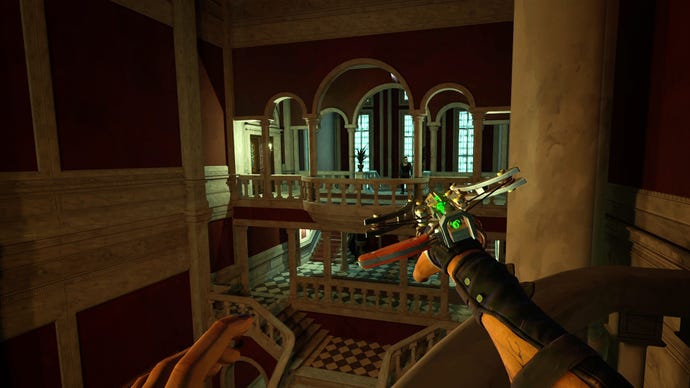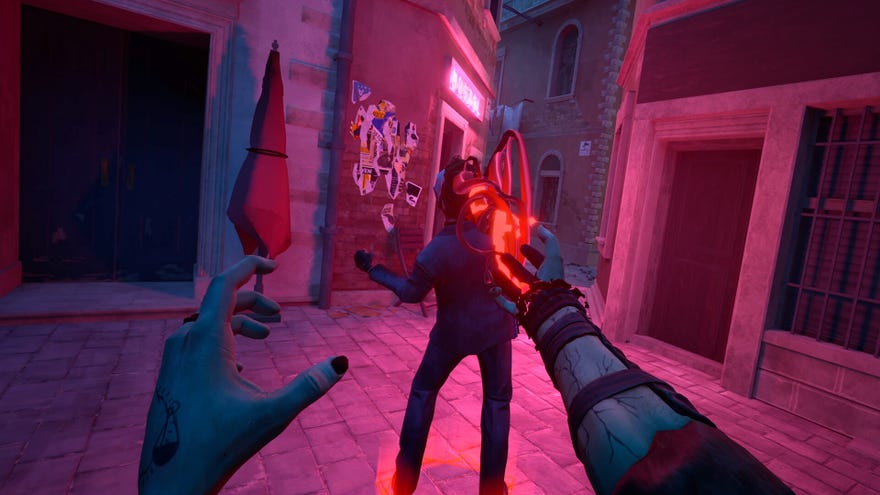Reality Bytes: Vampire: The Masquerade - Justice wants to be a bite sized Dishonored, but is defanged by sloppy design
A bloody mess
I'm beginning to think we should bury Vampire: The Masquerade back in the forsaken graveyard where it was originally dug up, or at least banish the toothy reprobate back to its pen & paper castle. I don't know how White Wolf's RPG is viewed in the land of table tops these days, but here in computerville it has delivered exactly one good video game in the last 25 years (and don't come gibbering to me about 2022's Swansong, it wasn't fit to polish Bloodlines' fangs). Sure, Bloodlines 2 might prove a winner, but given years of delays and a developer change, I'll believe it when I see it.
Which brings us to Vampire: The Masquerade - Justice, the beleaguered series' first prowl through the rain-slick streets of VR. In theory, this should be exactly my cup of haemoglobin; a gothic, linear stealth game where you use your vampire powers to sneak across the rooftops of Venice. In its mechanics and design, Justice aspires to be a cut down version of Dishonored. Unfortunately, it's in the cutting down where most of its problems arise. It's too cramped, too basic, and too fuzzy around the edges, and the whole experience ends up being a bit mid.
The setup is straightforward enough. You play a vampire rather unsubtly called Justice, who can be played with masculine or feminine voice and body type. Justice travels to Venice in search of a mysterious relic following the murder of their sire. Naturally, being a Masquerade game, the story gets considerably murkier as it goes along, although whether that's the same as getting more interesting is up for debate. Much of the narrative is delivered in fat dollops of exposition while you stand around sweating into your headset, which does rather distract from the events being moodily unfurled.
It opens strongly though. You arrive at night, via gondola, to track down your initial contact in Venice's vampiric underworld, a Nosferatu named Pietro. Your first glimpse of Venice is wonderfully atmospheric, with its baroque tenements looming above you as your gondola glides in the water, the moon shading the city in the hues of a muggy summer night. The game never quite looks this good again, sadly. But it maintains those darkly warm colours throughout, lifting many of the simpler environments later in the game.
While Venice's sultry nights may look inviting, Justice is about as welcome in the city as one of those massive, obnoxious cruise ships that damage the local architecture. The streets swarm with the goons of the local vampire coterie, and they're armed to the teeth. Justice themself belongs to the Banu Haqim clan, who are known more for subterfuge than strength. This means directly attacking enemies is rarely a good idea, so you're better off either avoiding them, or ambushing them from behind.
To that end, Justice has a variety of vampiric abilities at their disposal. They have a short-range telekinesis that can flick nearby objects into their hands (and then throw with incredible force). They can teleport short distances and up on to ledges. They can briefly turn invisible, and can deploy several more aggressive abilities to dispatch enemies with varying degrees of subtlety.

The building blocks for a fun, predatory stealth game are here, and they do sometimes come together. Lurking upon rooftops as you study enemy patrol routes, putting together a quick sequence of blinks to slip through the gaps, can be satisfying. And while the environments are quite constrained, the game tries to ensure most areas have multiple avenues of attack.
But the fun is drained from the experience by the fact that the mechanical design is simply not tight enough. The flick-based telekinesis, which is borrowed directly from Half-Life: Alyx, is nowhere near as reliable as in Valve's game. Countless times I tried to pick up a bottle to throw or a rat to feed on (more on those later) and it just didn't work, even though the object in question was highlighted.
This isn't the only system that's fiddly to grapple with. The blink teleport is more reliable than the telekinetic flick, but it's also oddly limited in its power. You can blink horizontally anywhere, but you can only blink up to higher ledges in set locations, suggesting there's a "right" way to bypass each stealth section, which contradicts the game's Dishonored heritage. In the third mission, you gain access to a wrist-mounted crossbow that can fire various types of dart. This is a crucial tool for nonlethally disabling guards. But firing a single dart is a four-stage process. You have to craft the dart (from blood, of course), insert it into the crossbow, prime the crossbow, and only then can you shoot.
This fuzziness extends to other actions like feeding. Using abilities in the game consumes blood, which is replenished by feeding off guards, rats, and other NPCs. You do this by grabbing your victim with your hands and bringing your head close to their neck, triggering a blood countdown meter. If you, ahem, pull out at the right moment, you get a bonus to your feed that also disposes of the corpse faster (Don't ask me how this works. Let's just say 'vampire magic'). Timing this right is difficult, as you sort-of stick to your enemy while feeding, and unsticking yourself involves either yanking your head away, or shoving your victim hard in the back. Thanks to the game's liberally interpreted physics, this can propel your victim quite some distance, including into the paths of other patrolling guards.

Indeed, the physics are one of Justice's big immersion breakers. I know I'm supposed to be a powerful vampire (although given Justice's fragility in combat, I'd argue the game is inconsistent on this point). But when you attack an enemy, it feels less like you're strong, and more like your foes are filled with helium. It reminds me of Bloodlines' own distinctly floppy melee combat. But in that game's defence, it's twenty years old, a much broader experience and physics was a new technology at the time. Being a VR game, physical interaction is one of Justice's main selling points, and it just doesn't feel particularly good beneath the fingers. It's floaty, fiddly and imprecise when it needs to be slick and reactive.
This lack of precision made me less tolerant of the game's other idiosyncrasies, like how it uses sparsely distributed checkpoint saves, and the fact that your power usage is strictly governed by your blood level, meaning you need to either limit their use, or feed with the frequency of a newborn baby. In a more tightly designed game, these might translate into interesting challenges. But they just made me more frustrated when the game's own sloppiness had me stumbling into detection.
In the end, Vampire: The Masquerade - Justice simply made me want to play Dishonored. Everything in it is a lesser version of something done better in Arkane's masterpiece, and the fact it's a VR game doesn't compensate for the shortcomings in the broader design. Masquerade obsessives might find some value in the story or the setting, but coming to it as a stealth fan, I found Justice to be sorely wanting.









